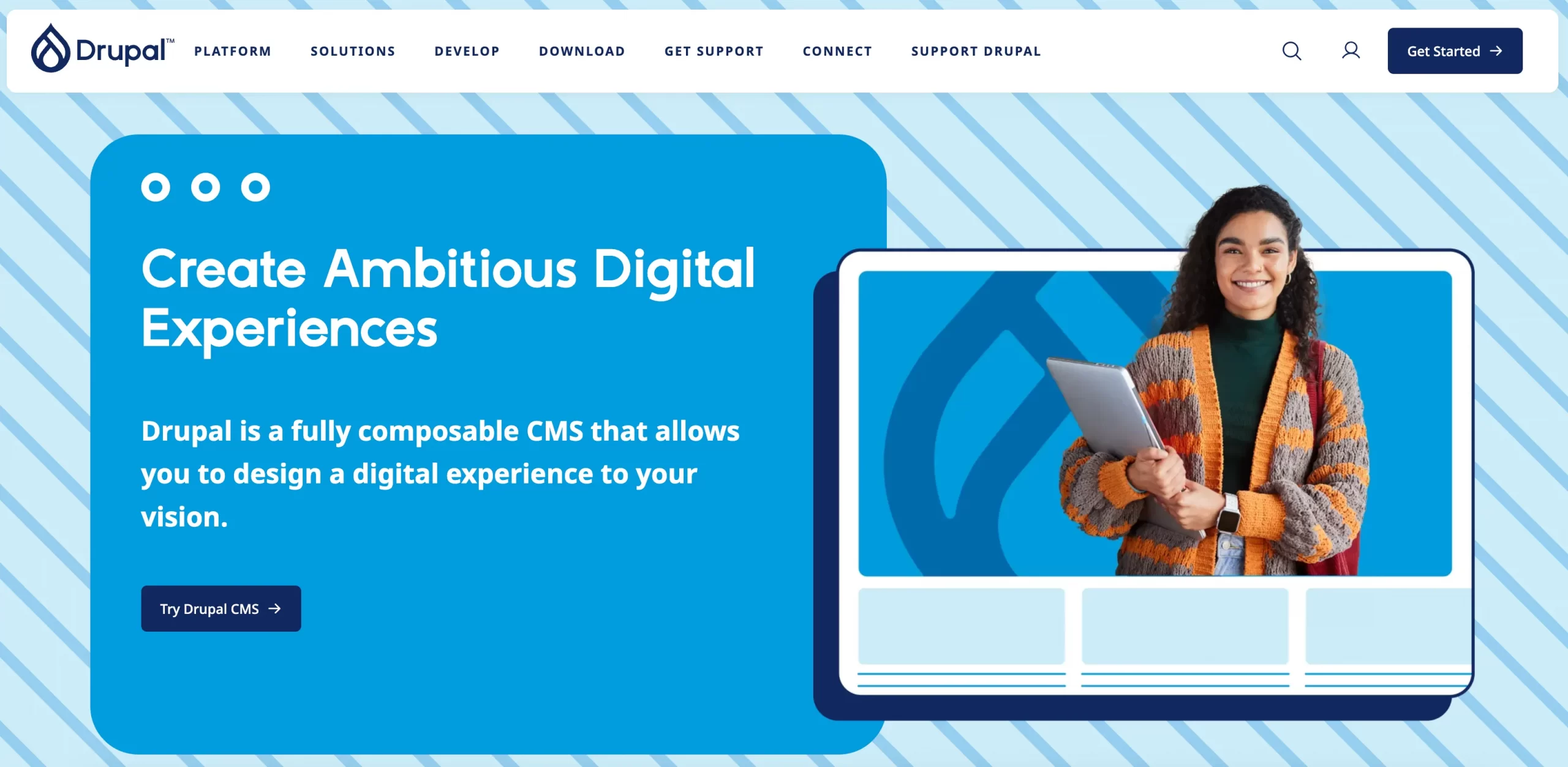If you’re building or scaling an eCommerce website in 2025, chances are you’ve come across both Drupal vs Magento. They’re two of the most powerful open-source platforms available — but they couldn’t be more different in how they approach eCommerce. One is rooted in content flexibility, the other in commerce-first functionality.
This article cuts through the noise to help you choose between them. We’ll break down not just features, but philosophies: Drupal as a modular CMS with optional commerce, vs Magento as a full-fledged eCommerce engine. By the end, you’ll know which platform better fits your business model, technical needs, and long-term roadmap.
Drupal vs Magento: Core Purpose and Platform Philosophy
Note: When comparing Drupal vs Magento, it's typically a battle between Drupal (extended with Drupal Commerce) against Magento Open Source — the free, community-driven version of Magento. While Adobe Commerce (the paid version) exists, it targets larger enterprises and sits in a different pricing tier. So for this comparison, we’ll focus strictly on Magento Open Source.
At their core, Drupal Commerce and Magento were built for different purposes.
Drupal started as a content management system (CMS), focused on flexible layouts, user permissions, and structured data. It was never built as an eCommerce platform, but with the Drupal Commerce module, it can be extended to support product catalogs, carts, and checkouts.
On the other hand, Magento is an eCommerce platform at its core. It was designed from day one to handle product-heavy stores, dynamic pricing, order workflows, and payment gateways. While it offers some content tools, its primary focus is — and has always been — selling online.
You may have heard of Adobe Commerce, which offers features for B2B, multi-source inventory, and advanced analytics. This comparison will stick with Magento Open Source, as it’s the version most commonly compared to Drupal. If you're looking for a quick overview of Magento, our team has created a comprehensive review video below.
In short:
- If your site is content-first with commerce as a layer, Drupal may fit.
- If your site is commerce-first with content as a supplement, Magento is likely the better choice.
Where Drupal and Magento Are Similar?
While Drupal and Magento serve different core purposes, they share several foundational qualities, especially from a technical and strategic perspective. If you're deciding between the two, it's helpful to know what you don't have to compromise on.
| Aspect | What they share |
| Open source & free | Both are freely available for use under open-source licenses, with large communities contributing to their ongoing development. |
| High customizability | Built for developers — both platforms support custom modules/extensions and deep backend flexibility. |
| Scalability | Designed to handle high-traffic, large-scale websites with the right infrastructure. |
| Security | Strong enterprise-level security practices and patch release cycles. |
| Multilingual & multisite | Native or module-based support for multilingual content and multi-site architectures. |
| API & headless capabilities | Both platforms can go headless or integrate with modern frontend frameworks via REST or GraphQL APIs. |
| Community support | Backed by vibrant global communities with active forums, meetups, and contributed modules. |
In short, both Drupal and Magento give you a powerful, scalable, and customizable foundation. But once you look beyond the similarities, the differences in purpose, workflow, and cost structure become much more significant, especially depending on whether you're content-first or commerce-first.
Drupal vs Magento: Key Difference Breakdown (2025)
| Category | Drupal (with Drupal Commerce) | Magento Open Source | Winner |
| Core purpose | Content-first platform extended with commerce capabilities | Commerce-first platform with basic CMS tools | Tie — use case dependent |
| Ease of use & setup | Flexible but complex; requires dev resources | Faster time-to-launch with native commerce stack | Magento |
| eCommerce features | Customizable, but built manually; fewer out-of-the-box features | Robust commerce engine, promotions, checkout, inventory prebuilt | Magento |
| Content management | Rich editorial control, content modeling, workflow, personalization | Basic CMS; strong for product content, not for structured editorial workflows | Drupal |
| Customization & flexibility | API-first, adaptable to a wide range of use cases | Powerful in commerce, but more rigid and complex for non-standard flows | Drupal |
| Extensions & modules | Versatile, often free, strong content and UX ecosystem | Focused on eCommerce; many paid extensions; needs vetting | Drupal |
| SEO & marketing tools | Full control over metadata, multilingual SEO, and open integration | Solid SEO for products; marketing tools require extensions or Adobe Commerce | Drupal |
| Performance & scalability | Lightweight, cloud-ready, scales with less infra | High-performance under load, but requires strong hosting & DevOps | Tie |
| Community & ecosystem | Open governance, strong global community across industries | Strong in eCommerce; but focus shifting toward Adobe Commerce | Drupal |
1. Pricing
When comparing Drupal Commerce vs Magento Open Source, costs and resource requirements are often the deciding factors, especially for businesses that need to balance flexibility, scalability, and development effort. Below is a practical breakdown of how the two platforms stack up in terms of real-world implementation.
| Criteria | Drupal (with Drupal Commerce) | Magento Open Source | Comparison |
| Licensing & platform costs | Free & open-source | Free & open-source | Equal on paper, but Drupal may need more configuration |
| Development & maintenance costs | $8,000 – $25,000+ (modular setup, content-first) | $10,000 – $30,000+ (eCommerce-ready, heavier dev setup) | Drupal is cheaper for content-driven; Magento is faster for commerce-first |
| Hosting requirements | Flexible (standard PHP hosting acceptable) | Needs optimized stack (VPS/cloud + caching, Redis, etc.) | Drupal is more lightweight and cheaper to host |
| Developer availability & hourly rates | $50 – $120/hr (moderate availability) | $75 – $150/hr (niche, specialized eCommerce devs) | Drupal devs are more affordable; Magento devs more eCom-specialized |
| Estimated initial build cost | $8K – $25K+ | $10K – $30K+ | Depends on scope — Drupal lower for hybrid, Magento higher for commerce |
| Monthly hosting cost | $20 – $200 | $40 – $400+ | Drupal is cheaper to maintain in most setups |
Both platforms are free and open-source, but that’s where the similarities end. Drupal is generally more cost-effective for content-first or hybrid use cases, with more flexible hosting and developer options. Meanwhile, Magento Open Source is purpose-built for commerce, and while it requires more technical overhead, it delivers a stronger foundation for complex online stores.
Verdict: It depends. If you're optimizing for editorial flexibility and control, Drupal wins. If you're focused on product management and transaction workflows, Magento is a better investment.
2. Ease of use
One of the biggest deciding factors — especially for non-technical teams — is how intuitive each platform is to use on a daily basis. From admin workflows to setup complexity, Drupal and Magento Open Source take very different approaches.
Drupal has enhanced its editorial experience with Drupal 11, providing a more polished admin UI, improved WYSIWYG editing via CKEditor 5, and smarter default configurations. But when it comes to initial setup, Drupal assumes a certain level of technical ability.

Hosting is flexible — you can run it on almost any LAMP stack — but installing Drupal Commerce means assembling multiple modules manually (products, carts, payments, etc.), defining your own architecture, and possibly creating custom code just to reach parity with a baseline eCommerce store. There are distributions that speed things up, but they're rarely plug-and-play.
On the other hand, Magento Open Source has a more opinionated structure, and while it demands more server resources, it also offers a more standardized setup. Hosting Magento requires a stronger environment (e.g., dedicated or cloud-based, often with Varnish, Redis, Elasticsearch), but the installation process is well-documented and unified.

Once installed, you’re immediately working with a complete eCommerce framework — products, checkout, promotions, and customer management are already built in. This makes Magento more accessible for merchants who want to go live quickly, as long as they have proper hosting in place.
Verdict: Magento Open Source wins for ease of use over Drupal, particularly in terms of initial setup. While its hosting requirements are steeper, its all-in-one eCommerce structure lets you get started faster with fewer moving parts.
3. Ecommerce capabilities
While both platforms support complex eCommerce operations, they excel in different areas. Below is a feature-by-feature comparison, backed by the latest data and real-world case studies as of 2025.
| Feature | Drupal Commerce | Magento Open Source |
| Product management | Custom product types, taxonomy support, flexible architecture; real-time inventory with modules like Commerce Stock. 24.2% of Drupal stores manage 1–9 products. | Advanced catalog features: configurable/bundled products, tiered pricing, and PIM integration. Used widely for medium to large product catalogs. |
| Checkout & payments | Highly customizable checkout flows; supports Stripe, PayPal, others via modules; PCI-compliant. | One-page checkout; express options (Apple Pay, PayPal, Google Pay); vaulted payments and fraud detection included in 2.4.7+. |
| Search & navigation | Faceted search with Solr/Elasticsearch; taxonomy-driven filtering; flexible navigation structure. | Layered navigation; smart autocomplete; AI-tuned search relevance and product recommendations. |
| Personalization | Limited built-in tools, but supports third-party AI personalization; ideal for custom content-product relationships. | AI-driven personalization via Adobe Sensei (in Adobe Commerce); Magento Open Source supports basic rules-based targeting and 3rd-party AI integrations. |
| Multi-region & multi-language | Module-based multi-language and pricing control; used by brands in 40+ countries (e.g., Lush). | Native multi-store and localization tools; supports currencies, tax zones, and regional storefronts out of the box. |
| Subscription & B2B | Modular B2B and recurring billing support; flexible for use in insurance, healthcare, and regulated industries. | Built-in B2B support in Adobe Commerce; Magento Open Source supports basic subscription flows with third-party modules. |
Drupal Commerce provides a flexible foundation for building an online store, but it doesn’t offer a simple experience. You’ll need to assemble various modules to create product types, cart logic, checkout flows, tax rules, and shipping methods. While this modularity allows for high levels of customization, it increases complexity and setup time. For content-led businesses or non-standard purchase flows, this flexibility is a strength; however, it requires experienced development resources.
In contrast, Magento Open Source is eCommerce-ready out of the box. It includes core commerce features such as advanced product management, inventory tracking, dynamic pricing rules, built-in checkout, and multi-store/multi-language support. Magento’s admin panel is also structured around typical merchant workflows, making it more practical for commerce-focused teams. With its rich extension ecosystem, store owners can enhance capabilities without starting from scratch.
Ready to power your online store with Magento’s built-in commerce engine? Migrate to Magento Open Source with LitExtension today!
Verdict: Magento Open Source wins in the eCommerce category. It delivers robust functionality immediately after installation and is better suited for product-driven, transaction-focused businesses.
4. Content management capabilities
Content management is a core differentiator between Drupal and Magento. While both platforms allow you to manage and publish content, they were built with very different priorities. In 2025, Drupal has evolved into a content powerhouse, while Magento remains focused on supporting commerce-related content needs.
| Capability | Drupal | Magento |
| Editorial experience | Modern interface (CKEditor 5), drag-and-drop layouts, real-time previews, bulk editing | Basic WYSIWYG editor and page builder for static content |
| AI integration | Native AI tools for content generation, layout, image QA, and smart tagging | Limited, mostly via third-party extensions |
| Content modeling | Highly structured (fields, entities, taxonomies, relationships) | Flat content structure; extensions needed for advanced modeling |
| Workflow & automation | Advanced tools like Workspaces and ECA for staged publishing and editorial automation | Basic workflow; limited automation without paid extensions |
| Personalization | Smart tagging, predictive layouts, real-time A/B testing | Product segmentation and rule-based personalization (mostly in Adobe Commerce) |
| Scalability & multisite | Supports hundreds of microsites with unified governance | Multi-store support for storefronts; weaker content governance |
| Best for | Enterprise content operations, publishers, higher ed, governments, global brands | Product-centric eCommerce brands that need basic page-building capabilities |
Drupal has a modern editing interface, native AI capabilities, and enterprise-grade scalability, it’s designed for organizations where content is a strategic asset. Editors benefit from real-time previews, drag-and-drop layout tools, and automation features that drastically reduce manual workload. The Drupal CMS introduces Experience Builder and enhanced AI personalization, putting editorial control directly into the hands of marketing teams.
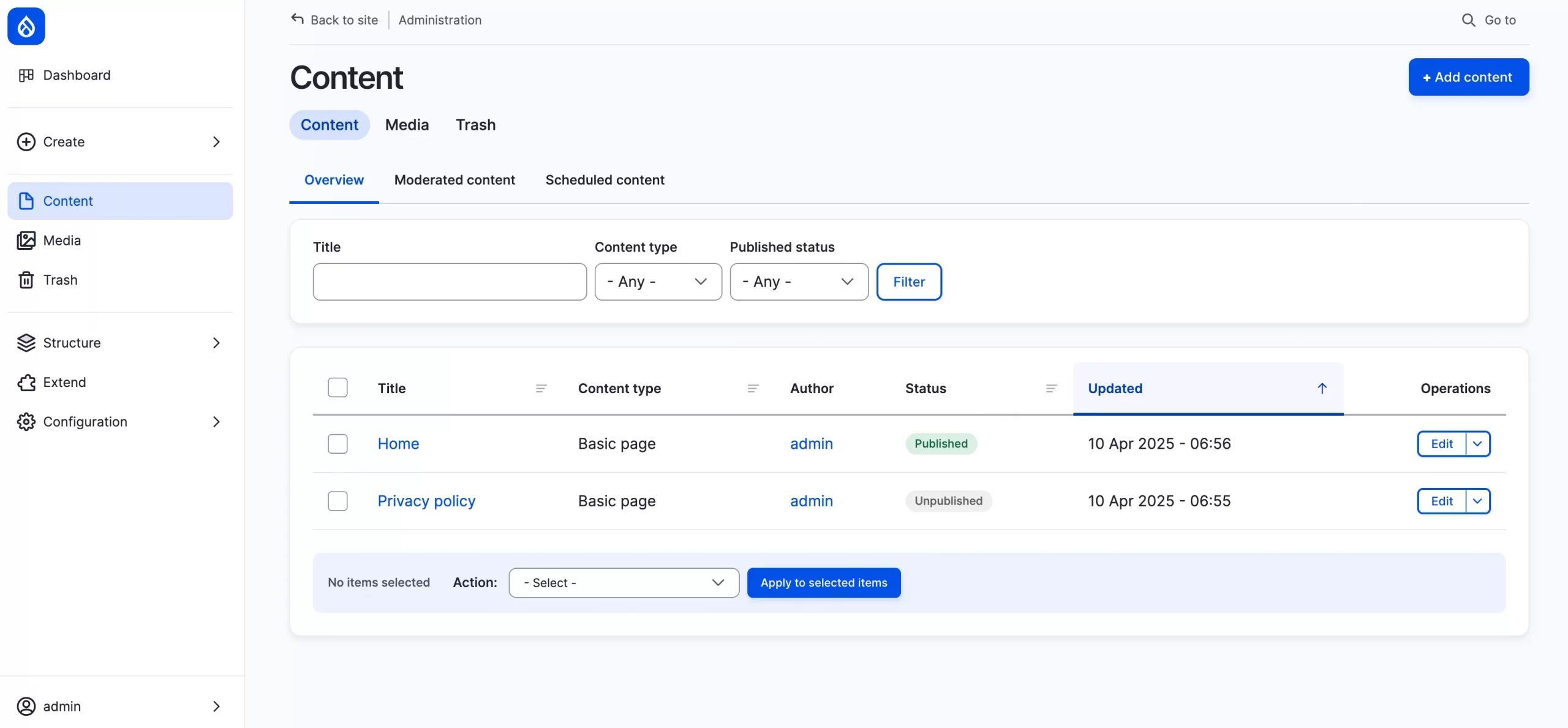
Magento, by contrast, provides only basic CMS functionality. It includes an editor for static content blocks, product descriptions, and landing pages, but it lacks advanced tools for editorial workflow, structured content modeling, or dynamic layout creation. While Magento does support content personalization (especially in Adobe Commerce), most advanced content features — like blogging, headless delivery, or AI-driven layout — require third-party extensions.
If your business relies on structured content, editorial control, and multilingual publishing, migrating to Drupal will provide the flexibility and scalability necessary for growth. Start your migration today!
Verdict: Drupal wins. In 2025, Drupal is the definitive leader in content management. It offers a robust, AI-enhanced editorial experience that scales across teams, languages, and even microsites — ideal for content-rich enterprises and global brands.
5. Customization and development flexibility
Both Drupal and Magento Open Source are open-source platforms that offer a high degree of customization. However, their flexibility manifests differently depending on your development priorities and technical stack.
Drupal is architected for extensibility from the ground up. Its modular system allows developers to customize nearly every layer of the experience: content models, user permissions, REST or GraphQL APIs, layout structures, and editorial workflows. Drupal follows a consistent, API-first development approach, making it ideal for complex builds, headless applications, and deeply integrated enterprise environments.
Magento Open Source also allows for deep customization, especially in product and checkout workflows. But its learning curve is steeper. The system relies on XML layouts, dependency injection, and a more rigid structure tailored to commerce-specific use cases. While powerful, Magento is less forgiving and more complex to extend, especially for teams building outside typical eCommerce patterns.
Verdict: In terms of overall customization and developer flexibility, Drupal is the clear winner. Its modular architecture, cleaner dev experience, and broader use case adaptability make it a better platform for teams that need full control over how the system behaves, both for content and commerce.
6. Extensions and modules
Both Drupal and Magento Open Source have vibrant ecosystems, but the nature, quality, and usability of their extensions differ based on the platform's primary purpose. Drupal has a long-standing reputation for its well-structured module ecosystem. As of 2025, there are over 53,000 contributed modules on Drupal.org.
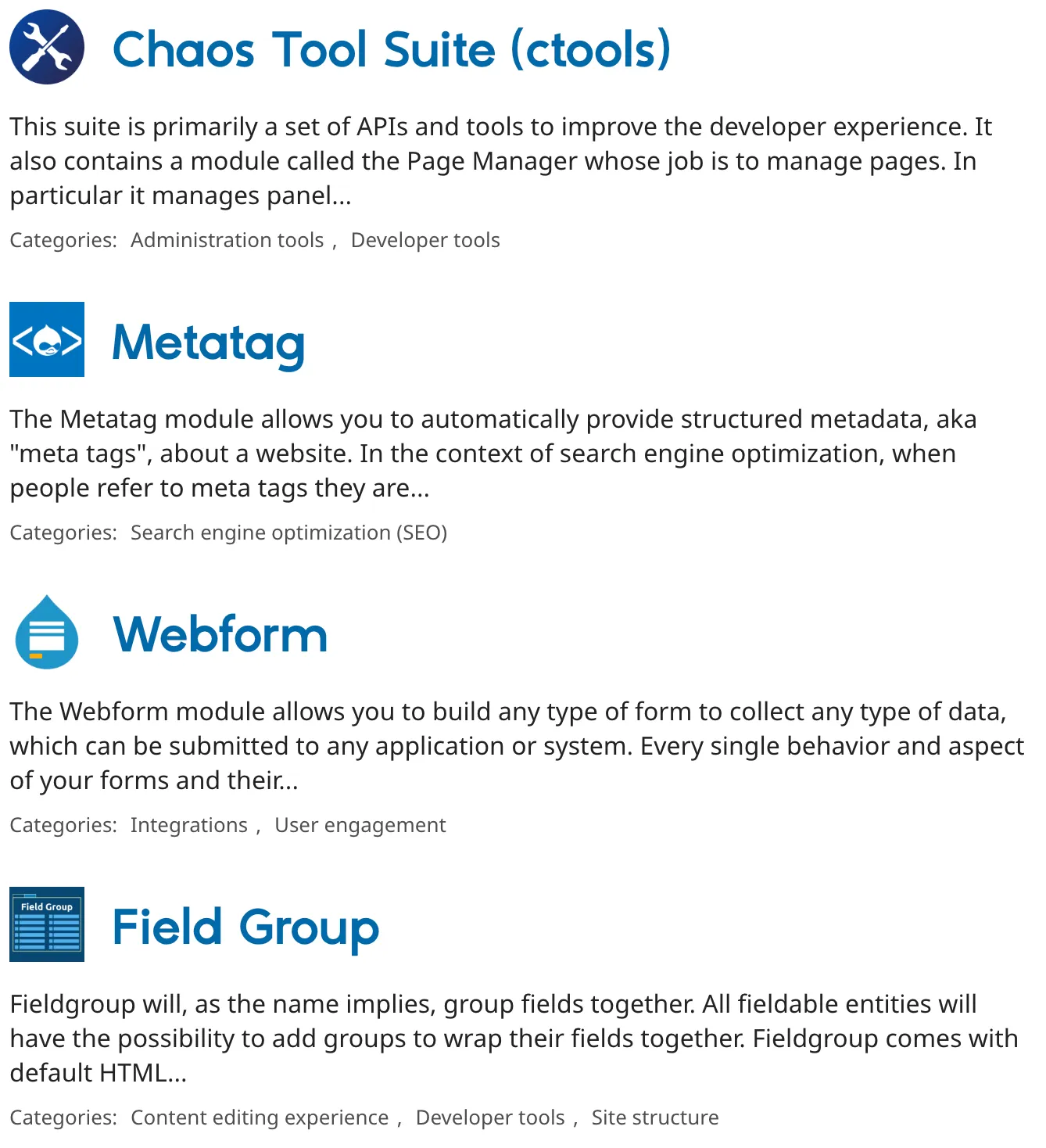
These cover everything from content moderation and SEO to multilingual support, layout builders, eCommerce components, and advanced user permissions. Modules are deeply integrated with core APIs, adhere to strict coding standards, and are regularly updated by an active open-source community. Most modules are free, and they are often composable, meaning you can combine them to build very specific use cases.
Magento Open Source, in contrast, offers over 4,000 extensions that are more narrowly focused on eCommerce, including payment integrations, shipping methods, loyalty programs, tax calculations, and performance tools.
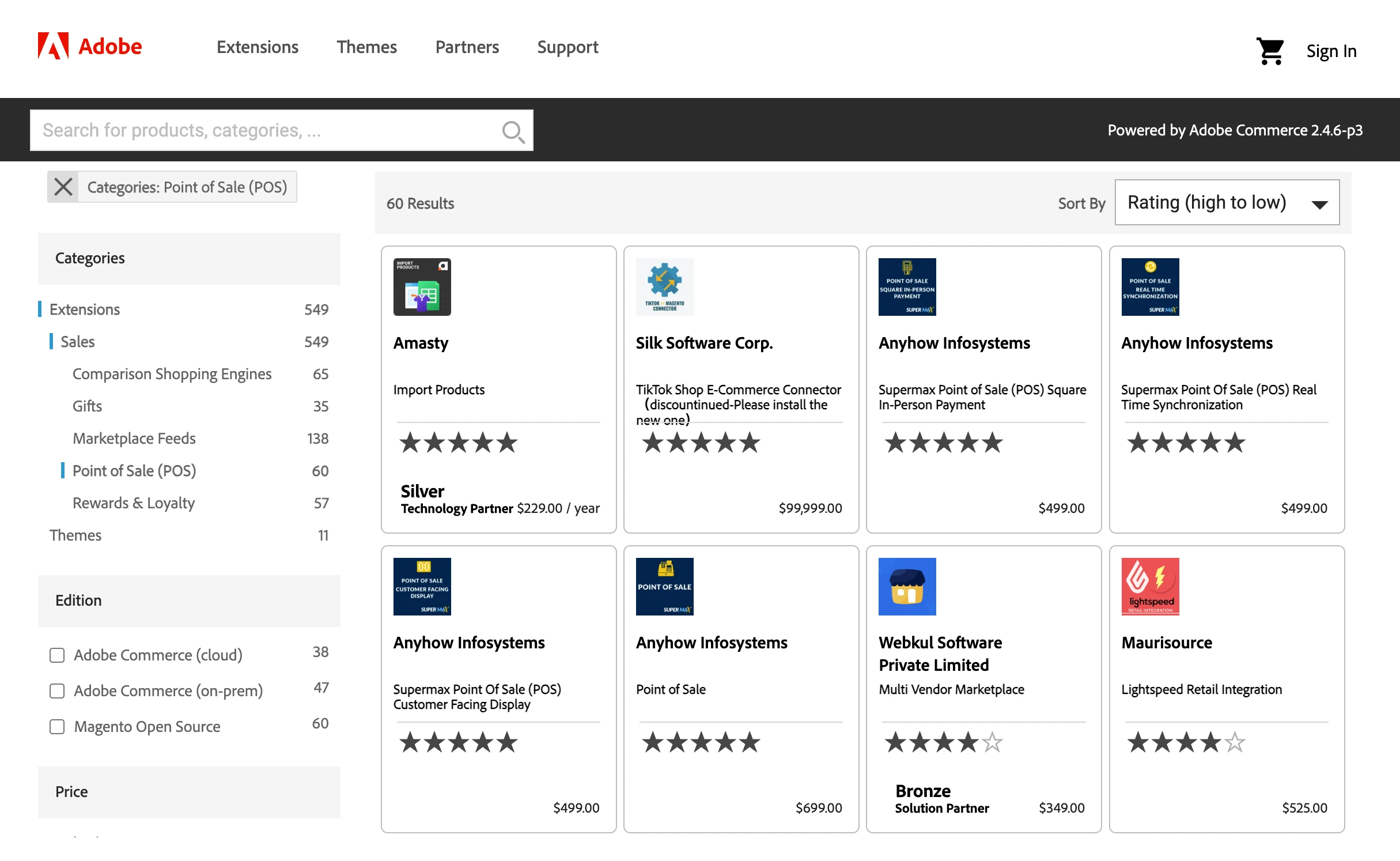
While powerful, many Magento extensions are paid and can vary in quality. It’s not uncommon for third-party modules to cause compatibility issues during core updates, which means Magento sites often require more QA and developer oversight during upgrades.
Verdict: Drupal wins for overall extension flexibility, integration quality, and ecosystem maturity. Its modules are more versatile, well-documented, and reliable across diverse use cases, especially outside of commerce.
7. SEO and marketing tools
SEO and digital marketing are essential for long-term growth, and this is where the difference between content-first and commerce-first platforms becomes clear.
Drupal provides fine SEO control through its core settings and powerful contributed modules, including Metatag, Pathauto, Redirect, and XML Sitemap. It supports multilingual SEO, custom schema, and page-level metadata — all deeply integrated into its content structure. Marketing flexibility is another strength, with modules for Google Tag Manager, Mailchimp, and more, without locking users into a specific ecosystem.
Magento Open Source also includes strong native SEO features like clean URLs, metadata control, and sitemap generation, optimized primarily for product and category pages. However, advanced editorial SEO or multichannel marketing features typically require third-party modules or Adobe Commerce.
Verdict: Drupal wins for SEO and marketing flexibility. It offers more robust, content-aware SEO features and open-ended marketing integrations, making it a stronger fit for brands that combine content strategy with commerce.
8. Performance and scalability
Both Drupal and Magento have seen significant improvements in 2025 in terms of performance and scalability, but they approach these areas in fundamentally different ways. The contrast lies in how efficiently they scale, how much infrastructure they demand, and what type of optimization each platform expects from your team.
Drupal is built around lightweight performance and flexible delivery. Page speed improvements in Drupal 10 and 11 — including built-in caching, responsive front-end rendering, and lazy loading — enable even large, content-driven websites to run quickly with relatively lean infrastructure.
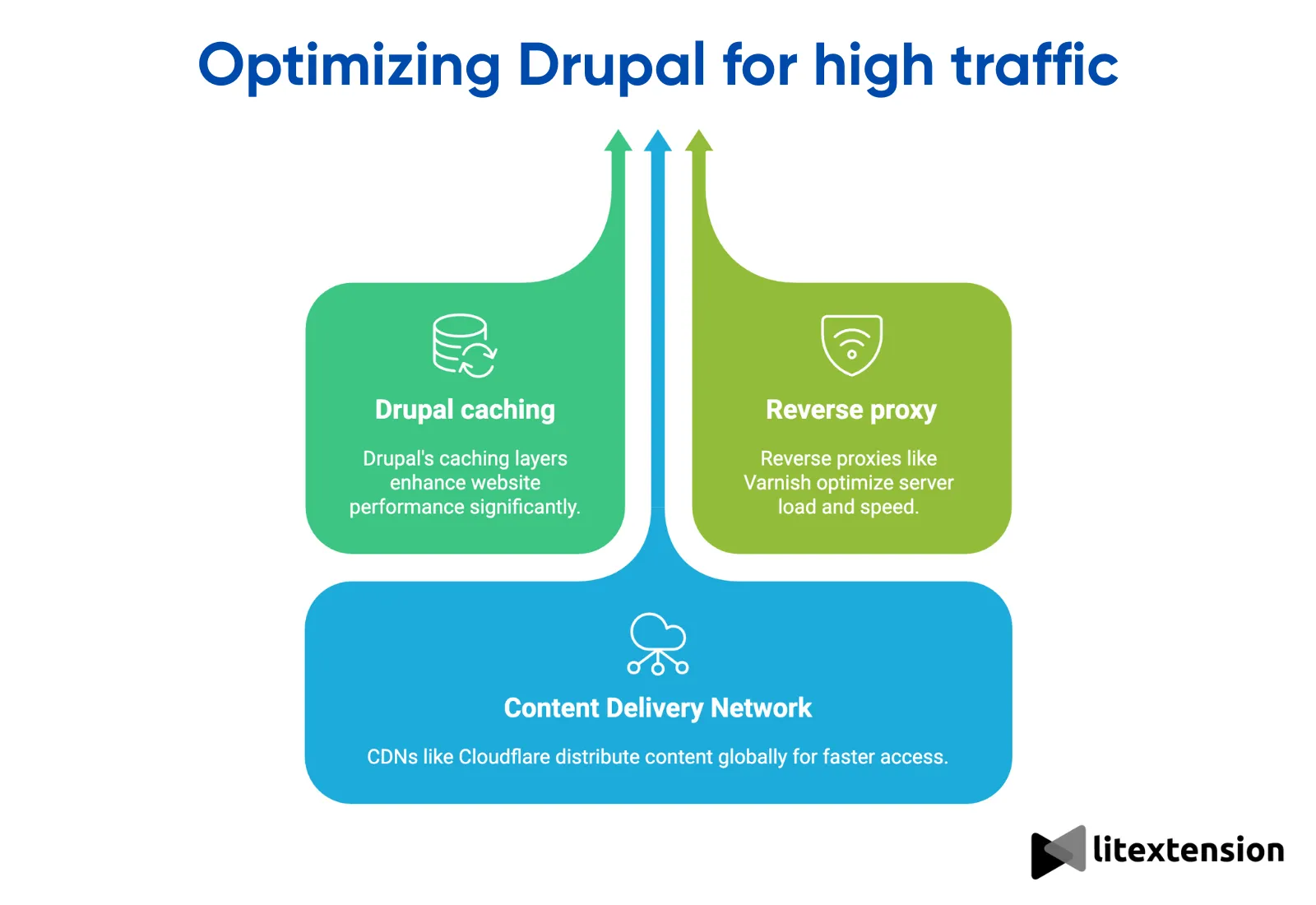
Tools like BigPipe and Advanced Page Cache enable the delivery of dynamic content without compromising overall performance, and integrations with AWS or GCP allow Drupal to auto-scale during unexpected traffic spikes. All of this makes Drupal highly efficient for global content distribution, without requiring over-engineered infrastructure.
Magento, in contrast, is optimized for transaction-heavy environments. It can handle large product catalogs, high order volumes, and personalized pricing, but it needs a tuned stack to do so. Performance depends heavily on tools such as Varnish, Redis, and CDN services (e.g., Fastly), and hosting should be purpose-built for these needs. While Magento is resource-intensive, it scales exceptionally well for global commerce when properly optimized.
Verdict: A tie. Drupal is more efficient for content-driven use cases, while Magento handles complex commerce operations at scale. Your infrastructure strategy and use case will determine which performs better in your context.
9. Community and ecosystem support
Both Drupal and Magento have mature open-source ecosystems, but the long-term health and direction of those communities are diverging.
Drupal is supported by a stable and transparent contributor model. The Drupal Association supports global events, such as DrupalCon, while thousands of developers continuously contribute to core and module development. Community contributions are openly governed, quality-vetted, and built around shared roadmaps. The ecosystem has also expanded to include enterprise partners, public-sector adopters, and contributors focused on AI, accessibility, and global scalability, making Drupal one of the most future-ready open-source platforms.
Magento also has a strong developer base, especially in the eCommerce space, and benefits from an established agency network. However, since Adobe’s acquisition, innovation has shifted increasingly toward Adobe Commerce, the paid version.
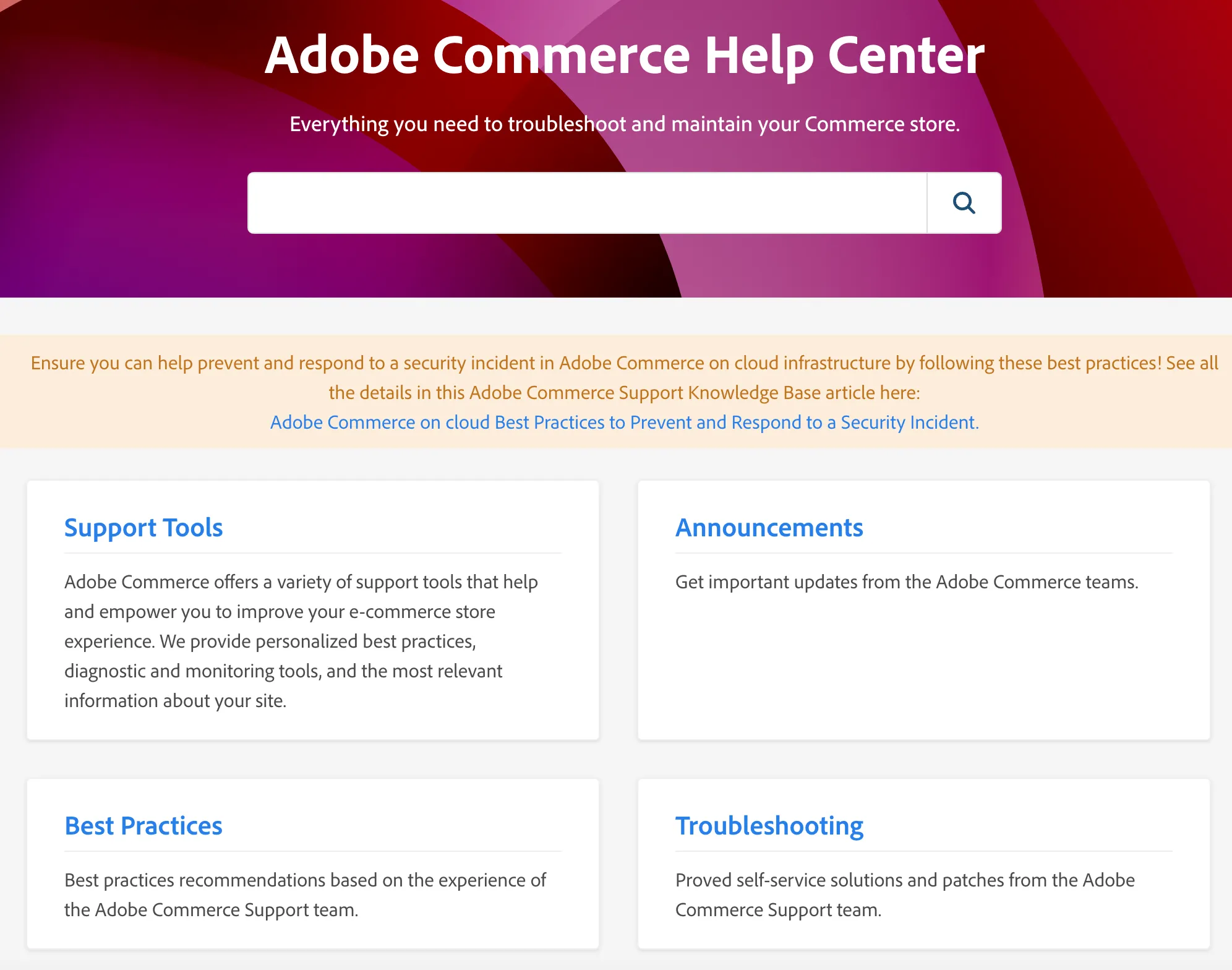
While Magento Open Source is still supported, many new features, including native AI and advanced personalization, are now gated behind Adobe’s commercial offerings. This split has raised concerns about long-term investment in the free version. The community remains active, but less influential over the core direction than Drupal’s.
Verdict: Drupal wins for community strength and ecosystem health. Its open governance model, consistent contributor engagement, and inclusive roadmap make it a more stable and community-driven platform in the long term.
Magento vs Drupal: Which One Should You Choose? (With Real-World Use Cases)
After reviewing core capabilities, performance, extensibility, and community support, the final choice depends on your priorities: are you building a content-first digital experience with commerce as a component, or a commerce-first platform that needs to scale product catalogs and transactions?
Choose Drupal if you are…
- A content-first organization — like a media site, NGO, university, or hybrid marketplace — where structured content, editorial workflows, and multilingual content delivery are key.
- Managing multiple content types and relationships (e.g., vendors, categories, events, user-generated content) that need to integrate smoothly with product offerings.
- Operating in highly regulated sectors (government, healthcare, education) where security, governance, and role-based access are critical.
- A team that values custom workflows, personalization, and full control over how commerce integrates with storytelling or service delivery.
Here’s a real-world example: Fooda. Fooda is a food service marketplace that utilizes Drupal to manage vendor listings, rich editorial content, and customer engagement — blending structured CMS features with commerce-like functionality, all within a single platform.
Choose Magento if you are…
- A product-first business — especially in retail, cosmetics, automotive, or B2B — with complex catalog structures, SKU management, and transactional needs.
- Running multiple storefronts across regions, languages, or customer segments, and requiring out-of-the-box support for promotions, pricing rules, and payment gateways.
- Planning to scale rapidly with a high volume of products, orders, and checkout interactions, where performance and conversion matter more than content flexibility.
- A merchant who wants robust commerce capabilities upfront and is willing to invest in infrastructure and development for long-term growth.
Let’s explore Sigma Beauty. This is an international beauty brand that utilizes Magento to power its multi-language, multi-store eCommerce platform, featuring advanced merchandising features, loyalty programs, and seamless checkout experiences.
Drupal vs Magento: FAQs
Is Drupal good for eCommerce?
Yes — when paired with Drupal Commerce, Drupal becomes a powerful eCommerce platform, especially for content-rich or custom use cases. However, it’s not out-of-the-box like Magento, and requires more development effort to configure product types, checkout flows, and payment integration.
Does Drupal support multi-store like Magento?
Not natively in the same way. While Magento has built-in multi-store and multi-language support tied to separate catalogs and regions, Drupal achieves this via multi-site or domain access modules. Drupal is better for content governance; Magento is stronger for commerce-focused multi-store operations.
Is Magento still used?
Absolutely. Magento Open Source remains widely used, particularly among mid-to-large businesses with complex catalogs or customized checkout requirements. That said, much of Adobe's innovation now happens in Adobe Commerce (paid), which may affect how the open-source version evolves over time.
Are AI tools available in either Drupal or Magento?
Yes, but differently. Drupal (via Drupal CMS 2025) now includes native AI features like smart tagging, layout generation, and content suggestions. Magento supports AI-powered product recommendations — primarily in Adobe Commerce, not the free open-source version.
Is Drupal or Magento easier to host and maintain?
Drupal runs on a wider variety of basic hosting setups and performs well even on lean infrastructure. Magento, while scalable, requires more powerful servers (often with Varnish, Redis, Elasticsearch) and is heavier to maintain without dedicated DevOps support.
Is Magento a CMS like Drupal?
No — and this is a key distinction. Drupal is a full-fledged content management system (CMS) designed for complex editorial workflows, custom content types, and structured publishing. Magento, by contrast, is an eCommerce platform that includes basic content features but lacks the depth of a true CMS unless extended with plugins
Which platform is better for SEO, Drupal or Magento?
Both Drupal and Magento are SEO-friendly, but Drupal offers more flexible, content-aware tools, while Magento focuses on product SEO. The right choice depends on whether your strategy prioritizes structured content or commerce-driven visibility.
Final Words
Both Drupal (with Drupal Commerce) and Magento Open Source are highly capable platforms, but they serve different goals.
Choose Drupal if your business is driven by content, personalization, or structured publishing. It’s built for flexibility, editorial control, and integrating commerce into a broader digital experience — ideal for organizations where storytelling and complex workflows are just as important as selling.
Choose Magento Open Source if your focus is selling at scale. It’s optimized for commerce-first workflows, large catalogs, and conversion-ready performance — perfect for merchants who want robust transactional features out of the box.
We hope you found this article informative and now have a clear understanding of the differences between Drupal vs Magento Open Source. For more content like this, be sure to visit the LitExtension blog and join our eCommerce community to gain further insights and connect with fellow business owners.
